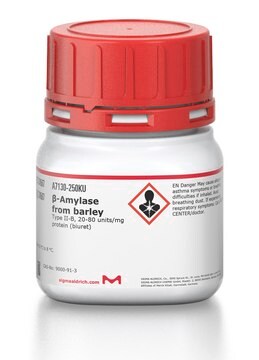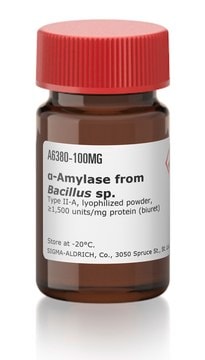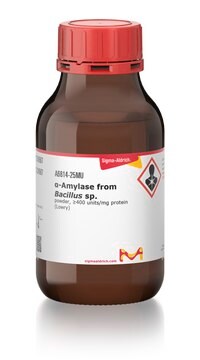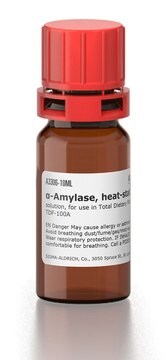10065
αα-Amilasa from Aspergillus oryzae
powder, ~30 U/mg
Sinónimos:
1,4-α-D-glucano glucanohidrolasa
About This Item
formulario
powder
actividad específica
~30 U/mg
mol peso
Mr ~51000
temp. de almacenamiento
2-8°C
¿Está buscando productos similares? Visita Guía de comparación de productos
Descripción general
Aplicación
- as a control enzyme in agar plate-based and carboxymethylcellulose-based clearing assays to screen cellulase activity
- for the hydrolysis of starch to explore the the role of wheat starch in frozen dough
- to inhibit Staphylococcus aureus biofilms
Acciones bioquímicas o fisiológicas
Definición de unidad
Otras notas
Palabra de señalización
Danger
Frases de peligro
Consejos de prudencia
Clasificaciones de peligro
Acute Tox. 4 Oral - Resp. Sens. 1
Código de clase de almacenamiento
11 - Combustible Solids
Clase de riesgo para el agua (WGK)
WGK 3
Punto de inflamabilidad (°F)
Not applicable
Punto de inflamabilidad (°C)
Not applicable
Equipo de protección personal
dust mask type N95 (US), Eyeshields, Faceshields, Gloves
Certificados de análisis (COA)
Busque Certificados de análisis (COA) introduciendo el número de lote del producto. Los números de lote se encuentran en la etiqueta del producto después de las palabras «Lot» o «Batch»
¿Ya tiene este producto?
Encuentre la documentación para los productos que ha comprado recientemente en la Biblioteca de documentos.
Los clientes también vieron
Nuestro equipo de científicos tiene experiencia en todas las áreas de investigación: Ciencias de la vida, Ciencia de los materiales, Síntesis química, Cromatografía, Analítica y muchas otras.
Póngase en contacto con el Servicio técnico







